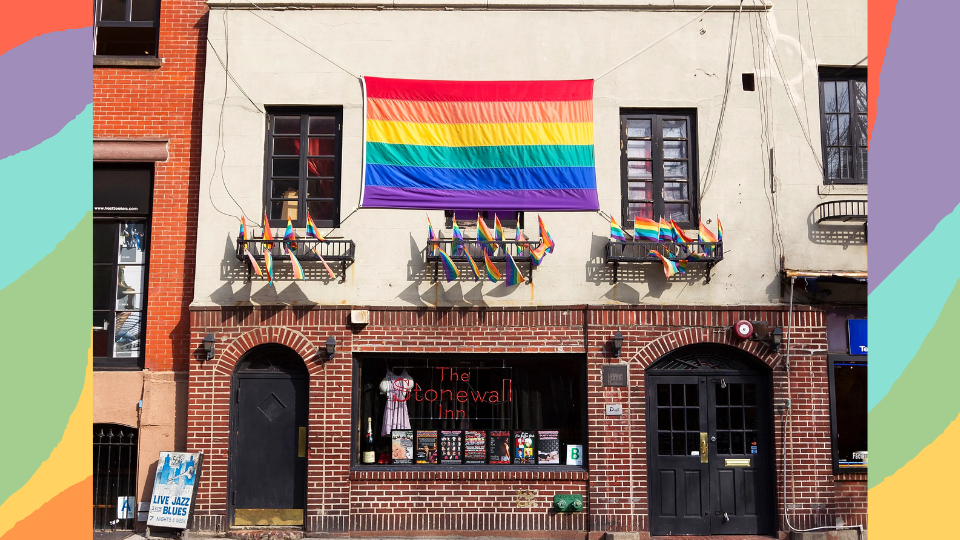
Perceptions of LGBTQ+ People in 1969
Queer and trans people were heavily discriminated against in all areas of society. For example:
- Legal: Prior to 1962, sodomy was a felony in every state punished by a lengthy term of imprisonment or hard labor. States, slowly and individually, began decriminalizing consensual sexual acts.
- Healthcare: DSM-I (1952): Homosexuality was classified as a "sociopathic personality disturbance." | DSM-II (1968): Homosexuality was listed as a "sexual deviation."
- Media: The Hays Code, a set of self-imposed guidelines for Hollywood films from 1934 to 1968, prohibited the portrayal of homosexuality and other "sexual perversions," leading to the negative stereotyping or outright erasure of LGBTQ+ characters.
Queer people had to hide their sexuality, even in the spaces they created for themselves, which were typically bars. Police raids on gay bars were routine in the 1960s. During a typical raid, bar patrons presented their identification and were "inspected": amab people dressed in full drag (typically known as "street queens" during this period) and women wearing less than 3 pieces of feminine clothing were arrested. Raids usually took place on weekday nights with smaller, easily controlled crowds and bar managers / owners were often tipped off before a raid started. Stonewall was different.
What happened at Stonewall?
At 1:20 a.m. on Saturday, June 28, 1969, police officers arrived at the Stonewall Inn, located on Christopher Street in Greenwich Village, and announced "Police! We're taking the place!" The music was turned off and the main lights were turned on. Approximately 200 people were in the bar that night, many of whom never experienced a raid before. The raid did not go as planned; patrons were refusing to show identification and refusing to be "inspected". During this process, police abused patrons, inappropriately touching lesbian patrons while frisking them and using excessive force to push or kick patrons out of the door when they were released.
A crowd began to form outside the bar, watching the police arrest patrons and put them into patrol wagons. The crowd witnessed the violence of the police for a time, but did not intervene until a handcuffed woman being dragged to the wagon shouted "Why don't you guys do something?" After an officer picked her up and heaved her into the back of the wagon, the crowd became a mob and became violent, sparking the riot. Street queens, lesbians, hustlers, patrons from nearby bars, and homeless queer youth who slept in nearby Christopher Park all joined in the demonstration. People threw coins, beer cans, and bricks from a local construction site, they slashed tires on the police cars and patrol wagons, and started fires. Officers grabbed several people from the crowd and barricaded themselves, the people they grabbed, and several handcuffed patrons in the bar.
The Tactical Patrol Force of the New York City Police Department arrived to free the police trapped inside the Stonewall. With the larger numbers, police violently detained anyone they could get their hands on, beating the crowd with batons and throwing people into the patrol wagons. According to reports, the riot was well underway by 2:00 am and was not over, with streets cleared until 4:00 am.
The Next Day
News of the riots spread quickly throughout Greenwich Village. The next evening, thousands of people gathered to riot, not only in front of Stonewall Inn, but on all of Christopher Street, spilling into adjoining blocks. Over a hundred police were present, but after 2:00 am, the Tactical Patrol Force arrived again, with street battling ensuing until 4:00 am.
The riots likely would have continued for several more days, but the rain dispersed the crowds.
Aftermath: The Origins of Pride
The feeling of urgency spread throughout Greenwich Village, even to people who had not witnessed the riots. Many who were moved by the rebellion attended organizational meetings, sensing an opportunity to take action. People started expressing their queerness out loud: kissing their partners, holding their hands, dressing in less restrictive ways. This organization persisted through planning Christopher Street Liberation Day.
Christopher Street Liberation Day, on June 28, 1970, marked the first anniversary of the Stonewall riots with an assembly on Christopher Street. With simultaneous Gay Pride marches in Los Angeles and Chicago, these were the first Gay Pride marches in US history.
The next year, 1971, Gay Pride marches took place in Boston, Dallas, Milwaukee, London, Paris, West Berlin and Stockholm. The march in New York covered 51 blocks, from Christopher Street to Central Park. By 1972, the participating cities included Atlanta, Buffalo, Detroit, Washington, D.C., Miami, Minneapolis, and Philadelphia, as well as San Francisco. Within two years of the Stonewall riots, there were gay rights groups in every major American city, as well as in Canada, Australia, and Western Europe.
Now
Attendance at LGBTQ Pride events has grown substantially over the decades. Most large cities around the world now have some kind of Pride demonstration; Pride events in some cities mark the largest annual celebration of any kind.